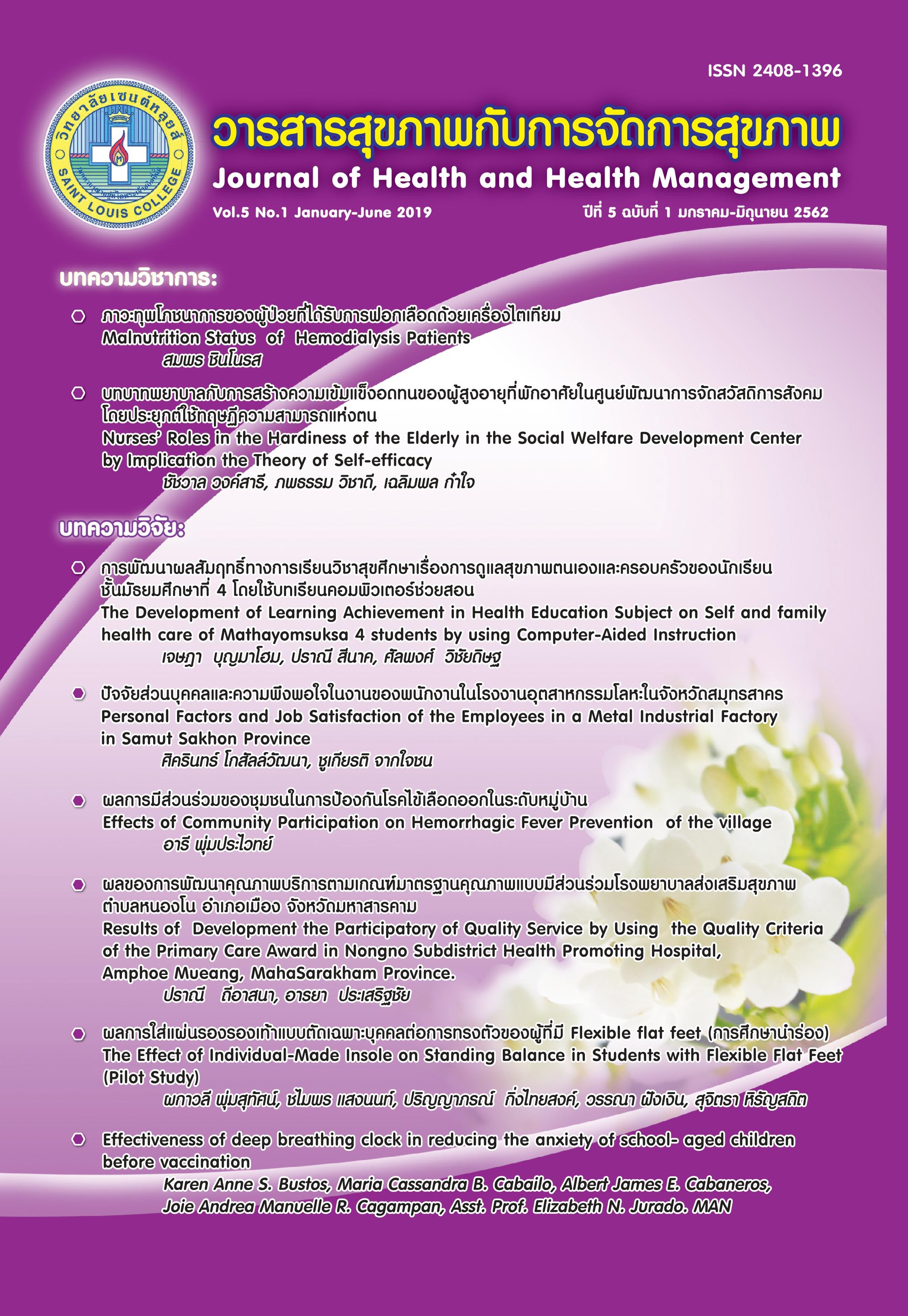Effects of Community Participation on Hemorrhagic Fever Prevention of the village
Keywords:
Mosquito larva, Dengue Hemorrhagic Fever Prevention and Control, Community ParticipationAbstract
The participatory action research, the objectives were 1. to study the level of the community participation. 2. to develop the preventive behavior of Denque Hemorrhagic fever. 3. to study the mosquito larva density index, by criteria of the Ministry of Public Health. The 43 samples were formal and informal leaders of the community. The tool were 1. in-depth interview. 2. Participate and non participate observation. 3. the preventive behavior of Denque Hemorrhagic fever interview. 4. The tool for observe mosquito’s larva density. The preventive behavior of Denque Hemorrhagic fever interview were approved by three experts, the IOC were 0.86. The results reveal that, the community participation was in the high level, the community member went to join the meeting and activity more than 90 %. The project results after participation of the prevention were 1. To present severity and risk of the disease. 2. To remove the source of mosquito. 3. Setting the group of people who feed the Poecilia reticulata Peters fish (Pla Hang Nok Yoong) for eating mosquito’s larva 4. Clear the mosquito larva in the house. 5. Spare the machine or material for reduce the mosquito and larva. Analyze data by descriptive statistic and paired t test, the mean score of preventive hemorrhagic fever behaviors after intervention was higher than before at a statistically significant (p < .05). The comparison larva between before and after participation program were met the values index of mosquito’s larva density were reducing: house index ; HI = 41.31 to 8.20, Container index ; CI = 31.44 to 7.48 and Breteau index ; BI = 62.52 to 18.64. The recommendations are that the community participation should be applied to the other communities that the same contexts to prevent and control dengue hemorrhagic fever.
References
จีระศักดิ์ เจริญพันธ์. (2554). การจัดการสาธารณสุข ในชุมชน. (พิมพ์ครั้งที่ 6). มหาสารคาม: สารคาม การพิมพ์ - สารคามเปเปอร์
ดาบชัย มาภา. (2550). การมีส่วนร่วมของชุมชนในการ ป้องกันควบคุมโรคไข้เลือดออก อำเภอท่าอุเทน จังหวัดนครพนม. (วิทยานิพนธ์ปริญญาสาธารณสุข ศาสตรมหาบัณฑิต สาขาวิชาการจัดการระบบ สุขภาพ). บัณฑิตวิทยาลัย มหาวิทยาลัยมหาสารคาม.
พัสกร สงวนชาติ. (2552). ผลการจัดการแบบมีส่วนร่วม ของชุมชนที่มีต่อการป้องกันและควบคุม โรคไข้ เลือดออก ตำบลพระลาน อำเภอเฉลิมพระเกียรติ จังหวัดสระบุรี. (วิทยานิพนธ์สาธารณสุขศาสตร มหาบัณฑิต สาขาวิชาการจัดการสุขภาพ). บณั ฑติ วิทยาลัย: มหาวิทยาลัยมหาสารคาม.
มรกต หน่อศักดิ์. (2552). การมีส่วนร่วมในการป้องกัน และควบคุมโรคไข้เลือดออก ตำบลป่าไผ่ อำเภอ สันทราย จังหวัดเชียงใหม่. (วิทยานิพนธ์พยาบาล ศาสตรมหาบัณฑิต สาขาการพยาบาลชุมชน). บัณฑิตวิทยาลัย มหาวิทยาลัยเชียงใหม่.
โยมา ประดิษฐ์. (2552). ผลของการวางแผนแบบมีส่วน ร่วมของประชาชนในการป้องกันและควบคุมโรค ไข้เลือดออกบ้านหนองบัว ตำบลนาดี อำเภอหนองแสง จังหวัดอุดรธานี. (วิทยานิพนธ์สาธารณสุขศาตร มหาบัณฑิต สาขาการบริหารสาธารณสุข). บัณฑิต วิทยาลัย มหาวิทยาลัยขอนแก่น.
รัชนี ถิตย์ประเสริฐ. (2552). การมีส่วนร่วมของชุมชนใน การป้องกัน และควบคุมโรคไข้เลือดออก ตำบลบ่อแก้ว อำเภอนาคู่ จังหวัดกาฬสินธุ์. (วิทยานิพนธ์ สาธารณสุขศาสตรมหาบัณฑิต). บัณฑิตวิทยาลัย มหาวิทยาลัยขอนแก่น.
สาธารณสุข, กระทรวง กรมควบคุมโรคติดต่อสำนักโรค ติดต่อนำโดยแมลง กลุ่มโรคไข้เลือดออก. (2553). คู่มือการประเมินผลตัวชี้วัดงานป้องกัน และควบคุมโรคไข้เลือดออก ระดับจังหวัด ปี 2553. (พิมพ์ครั้งที่ 1).
สำนักงานสาธารณสุขจังหวัดสุราษฏร์ธานี. (2557). สรุปรายงานการเฝ้าระวังไข้เลือดออก ประจำปี 2557.
สำนักงานสาธารณสุขจังหวัดสุราษฏร์ธานี. สำนักงานสาธารณสุขอำเภอวิภาวดี จังหวัดสุราษฏร์ธานี. (2558). สรุปรายงานการเฝ้าระวังไข้เลือดออก ประจำปี 2558. จังหวัดสุราษฏร์ธานี.
สำนักโรคติดต่อนำโดยแมลง กรมควบคุมโรค. (2553). แนวทางการควบคุมโรคไข้เลือดออกสำหรับ เจ้าหน้าที่สาธารณสุข. นนทบุรี.




